House prices in Lima have risen in Q3 2018
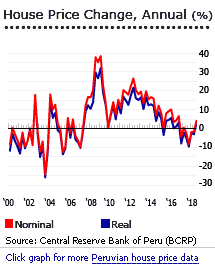 After taking a hit from economic slowdown in 2017, house prices in Lima started to rise again in Q3 2018, supported by an improved economy, lower borrowing costs, and accessible social housing programs. Lima´s house prices rose by 3.94% (2.62% in real terms) to PEN 6310 (US$ 1,891) per square metre (sq. m.) during the year to Q3 2018, according to the Central Reserve Bank of Peru (BCRP).
After taking a hit from economic slowdown in 2017, house prices in Lima started to rise again in Q3 2018, supported by an improved economy, lower borrowing costs, and accessible social housing programs. Lima´s house prices rose by 3.94% (2.62% in real terms) to PEN 6310 (US$ 1,891) per square metre (sq. m.) during the year to Q3 2018, according to the Central Reserve Bank of Peru (BCRP).
House price growth in Peru has weakened since 2014, due to the economic slowdown caused by declining copper prices. In 2014, Peru´s economic growth slowed to 2.4%, followed by 3.3% growth in 2015. In 2016 there was 4% growth, but that was followed by another slowdown to 2.5% growth in 2017.
Prior to these recent years, the country had enjoyed strong growth from 2010 to 2013, and the housing market boomed during those years.
Nominal and Inflation-adjusted House Price Change in Peru |
||
| Nominal | Inflation-adjusted | |
| 2010 | 15.18% | 12.83% |
| 2011 | 17.89% | 12.56% |
| 2012 | 18.13% | 15.09% |
| 2013 | 15.49% | 12.28% |
| 2014 | 12.03% | 8.53% |
| 2015 | 9.08% | 4.48% |
| 2016 | 6.52% | 3.18% |
| 2017 | -8.39% | -9.62% |
| Source: Central Reserve Bank of Peru (BCRP) | ||
The outlook for 2019 is quite positive. Ricardo Arbulú, vice president of the Association of Real Estate Companies of Peru (ASEI) projects house price increases of between 4% and 7% in 2019, depending on the district. Arbulú points out that a factor likely to push up sales prices upward is the shortage of real estate supply.
Home sales are up during the first half of 2018
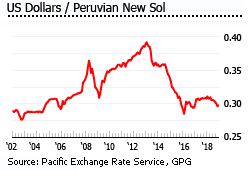 There was a 12.6% increase in the number of housing units sold in Lima and Callao from August 2017 to July 2018, according to the Peruvian Chamber of Construction (Capeco). "It is the second year of consecutive growth, which interrupted a three year period of sharp decline in which sales volume was reduced to less than half, compared to the record of 22,220 units in 2013," Capeco Executive Director Guido Valdivia noted.
There was a 12.6% increase in the number of housing units sold in Lima and Callao from August 2017 to July 2018, according to the Peruvian Chamber of Construction (Capeco). "It is the second year of consecutive growth, which interrupted a three year period of sharp decline in which sales volume was reduced to less than half, compared to the record of 22,220 units in 2013," Capeco Executive Director Guido Valdivia noted.
The highest number of housing units sold was in Modern Lima (Jesús María, Lince, Magdalena del Mar, San Miguel, Pueblo Libre, Surquillo and part of Santiago de Surco), with about 36.17% of total sales. It surpassed Lima Top (Barranco, La Molina, Miraflores, San Isidro, San Borja and part of Santiago de Surco) which had a 25.13% share, and Lima Center (Cercado de Lima, Rímac, Breña, La Victoria and San Luis ) which had a 12.38% share.
Despite the political crisis early last year, the real estate market seems unaffected, according to ASEI President Rodolfo Bragagnini. Bragagnini noted that "the biggest political crisis, when the resignation of the president occurred, was also the period in which it was sold the most" and attributed this to Peru´s economic stability. "The rates went down, the Government has worked very well with Techo Propio Mivivienda and the lags were corrected quickly, that has allowed more placements," according to Bragagnini.
Since the beginning of 2013 the New Peruvian Sol has fallen from US$1=PEN 2.55 to US$1=PEN 3.34, largely due to copper price weakness. This reduces costs for foreign buyers.
Foreign residents and nonresidents alike may buy Peruvian property. Investment in Peruvian property does not require government approval, except if such property is close to Peru´s frontiers.
Positive economic outlook in 2019
From a stronger expansion of about 4% in 2016, Peru´s economy slowed to 2.5% in 2017, mainly attributed to:
- Floods brought by the "Coastal El Niño" phenomenon during the first quarter of 2017, which contributed to the slowdown in domestic demand;
- Investment fell as infrastructure projects were halted partly due to the Odebrecht / "Lava Jato" corruption scandal.
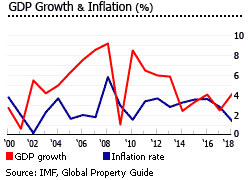
During the second half of 2017, the negative impact of the "Coastal El Niño" gradually dissipated and domestic demand recovered. However, the growth was still limited due to weaker exports of copper and fish.
The economy stated to pick up again in 2018, as the government focused on rehabilitation of areas and infrastructures affected by "Coastal El Niño". Domestic demand remained strong, backed by a recent minimum wage hike, low inflation, and increasing employment. And while the country faces political uncertainty, Economy and Finance Minister Carlos Oliva said that this has not affected the economy.
"We do not see any impact on the country´s economy. Political noise is not good, but what is important is that we are on the way towards finding a solution," according to Minister Oliva.
Peru´s GDP rose by 4% in 2018, and this growth is expected to continue in 2019 also at 4%, according to the Central Reserve Bank of Peru (BCRP).
In December 2018, inflation stood at 2.19%, up from last year´s 1.36%. Unemployment was down to 5.7% in November 2018, from 6.5% in the previous year, according to the Central Reserve Bank of Peru (BCRP).
Yields are falling
Gross rental yields on prime residential property in central Lima are moderate and have been on a declining trend over the past few years. Apartments in Lima have rental yields ranging from 4.3% to 5.9%, based on the Global Property Guide research in November 2017.
Gross rental yields have significantly declined over the past few years:
- In 2009, yields ranged from 9.46% to 13.56%.
- In 2010, yields ranged from 7.30% to 10.66%.
- In 2011, yields ranged from 6.68% to 8.86%.
- In 2013, yields ranged from 6.29% to 9.15%.
- In 2014, yields ranged from 5.25% to 7.62%.
- In 2015, yields ranged from 5.16% to 6.15%.
- In 2016, yields ranged from 5.77% to 5.80%.
Lima´s rental prices are usually set in US dollars. Over the last five years, the Peruvian Nuevo Sol (PEN) has depreciated sharply, which could have pushed (the already declining) rental prices even lower. In Lima, the highest average monthly rent for two-bedroom apartments (100 sq. m.) can be found in Barranco at around PEN 3,533 (US$ 1,055). Average monthly rents in Miraflores and San Isidro are also quite expensive, at above PEN 3,013 (US$900). Rents are relatively cheaper in the district of La Molina at around PEN 1,895 (US$ 566) per month.
Lower Sol-denominated mortgage rates; small but expanding mortgage market
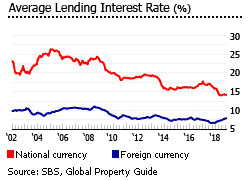
In December 2018, the Central Reserve Bank of Peru (BCRP) decided to keep its benchmark rate unchanged at 2.75% for the tenth consecutive month, as inflation is within the target range of 1% to 3%, although economic output level is still "below its potential". The BCRP made its latest rate cut in March 2018.
Although still very high, the average lending rate for loans denominated in Peruvian New Sol (PEN) fell to 14.2% in November 2018, from 16.1% in the previous year. In contrast, the rate for foreign currency loans actually increased to 7.94% in November 2018, up from 6.75% a year earlier.
Mortgage loan rates significantly fell from the second half of 2017 to the first half of 2018. The average rate for mortgages denominated in PEN dropped by more than one percentage point from 8.53% in June 2017 to 7.30% a year later, according to the Superintendency of Banking and Insurance (SBS). Much of the decline was attributed to the strong competition in the mortgage market, according to Ministry of Housing, Construction and Sanitation (MVCS) Deputy Minister of Housing Jorge Arévalo.
The MVCS projects a further drop in mortgage rates due to the significant competition among financial entities and strong demand for loans. In contrast, the Association of Real Estate Companies of Peru´s (ASEI) vice president Ricardo Arbulú sees a rate hike in early 2019, due to the US Federal Reserve´s plan of increasing its benchmark interest rate. "The FED will gradually increase its reference rate, which will affect local banks, causing their funding to be a little higher," according to Arbulú.
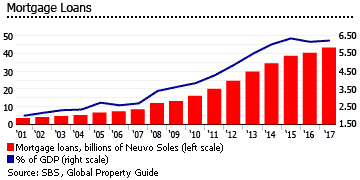
Peru´s mortgage market is still relatively small, at around 6.2% of GDP in 2017. In November 2018, the total outstanding mortgage loan increased by 9.71% from the previous year to about PEN 47.18 billion (US$ 14.09 billion), according to the Superintendency of Banking and Insurance (SBS).
Mortgage loans in Peru were predicted to have grown close to 10% by the end of 2018, and are expected to grow further in 2019, according to Scotiabank. Scotiabank is expecting a higher level of private investment growth this year, which boosts housing demand.
Peruvians approved new political and judicial reforms; solid approval rating for new President Vizcarra
On December 9, 2018, Peruvians held a constitutional referendum aimed at reforming the existing political and judicial system. This referendum was initiated by Peru´s newest head of state, President Martin Alberto Vizcarra Cornejo, who previously served as Peru´s First Vice President under former president Pedro Pablo Kuczynski´s term.
In the referendum, Peruvians were asked on whether they approve these proposed reforms:
- The conformation and functions of the National Board of Justice (formerly the National Council of the Magistracy);
- The regulation of political parties´ private financing;
- The prohibition of the immediate re-election of legislators;
- The establishment of a bicameral legislature.
Based on the poll´s results, Peruvians approved the first three reforms and rejected the one that suggested a bicameral legislature. The rejection was attributed to the objection made by President Martin Vizcarra to the changes made by the Congress to the proposed bicameral legislature project by the Executive Branch.
President Vizcarra vowed to fight corruption "head on" as soon as he took office early last year, following the various corruption scandals involving top public officials.
Among those top politicians include Vizcarra´s predecessor former president Pedro Pablo Kuczynski, who resigned from office on March 21, 2018 after the release of video clips showing an alleged vote-buying attempt of his supporters to aid in blocking Kuczynski´s second impeachment vote. Kuczynski´s first impeachment proceeding was related to his admission of receiving advisory fees, through his company Westfield Capital Ltd, from the scandal-plagued Odebrecht construction company from Brazil, during his stint as Peru´s Minister of Economy and Finance a decade ago.
Kuczynski is currently being investigated by Peruvian anti-graft prosecutors for his involvement to Odebrecht, along with three other former presidents: Alejandro Toledo (2001-2006), Alan García (1985-1990, 2006-2011), and Ollanta Humala (2011-2016), as well as the opposition leader and Kuczynski´s closest opponent in the 2016 elections, Keiko Fujimori.
As of December 2018, President Vizcarra´s approval rating remains solid at 61%, nine months after he took office, according to the latest poll from Peruvian Studies Institute (IEP).
Social housing
In 2014, Peru´s housing shortage was estimated at around 1.86 million units, according to Scotiabank. Based on more recent figures from the consultancy HGP Group, Metropolitan Lima had a housing deficit of around 612,464 housing units in 2016, with the district of San Juan de Lurigancho having the biggest deficit of about 15.6% of the total.
To reduce the housing deficit, the government has long provided financial aid and direct subsidies, such as MiVivienda, Techo Propio, Micasa Mas, Mi Construccion, and MiTerreno.
MiVivienda, established in 1999, provides housing loans for the middle and upper class levels (A, B and C). MiVivienda provides mortgages up to US$30,000. The New Credit MiVivienda finances the purchase completed or under construction homes whose total cost is from PEN 57,500 (US$ 17,329) up to PEN 410,600 (US$ 123,747).
Techo Propio is a program launched in 2002 directed at family groups who do not have their own houses and have never received State support to build or buy one. The total monthly income a household earns should not be more than PEN 3,626 (US$ 1,093) for house purchase and PEN 2,658.25 (US$ 801) for home construction or improvement. Techo Propio offers subsidies, which vary depending on the purpose:
- For purchasing houses, the subsidy granted is up to PEN 33,600 (US$ 10,126)
- For building houses, the subsidy granted can be PEN 22,890 (US$ 6,899)
- For improving houses, the subsidy granted is up to PEN 9,660 (US$ 2,911).
Micasa Mas is a credit program that is intended for families who already own a home (including homes that are under mortgage) that could be put on sale, in order to buy a new or used house that matches their family´s current financial and family situation. Loans that could be requested in this program range from PEN 45,000 (US$ 13,562) to PEN 270,000 (US$ 81,372), with a minimum down payment of 20% of the home´s value.
Mi Construccion allows beneficiaries to build, enlarge or improve their homes. Loans can be up to PEN 100,000 (US$ 30,138) with a repayment term of up to 12 years.
MiTerreno helps low-income families purchase an urban land (private or public) that will be used for housing purposes. The maximum amount of fund is around PEN 50,000 (US$ 15,069), with a maximum financing period of 8 years.
Out of all five programs, New Credit Mivivienda had the largest share in the total number of loans disbursed by Fondo Mivivienda in 2017 at 94.1%, according to Fondo Mivivienda´s June 2018 Bulletin, followed by Techo Propio (4.9%) and MiConstrucción (0.59%). New programs Micasa Mas (0.24%) and MiTerreno (0.15%) have the smallest shares. From January to June 2018, around 3,957 loans were disbursed under the five programs, amounting to PEN 473 million (US$ 142 million).
SOURCES:
- FOTOS | ¿Cómo terminaron los precios de los departamentos en el 2018?: https://elcomercio.pe/economia/dia-1/terminaron-precios-departamentos-2018-noticia-597494
- Venta de viviendas crece 12.6% en Lima Metropolitana y el Callao: https://andina.pe/agencia/noticia-venta-viviendas-crece-126-lima-metropolitana-y-callao-735720.aspx
- Venta de viviendas habría crecido más de 11% en el primer semestre: https://peru21.pe/economia/venta-viviendas-habria-crecido-11-primer-semestre-420322
- Venta de viviendas en Lima Metropolitana creció 12,6% en 2018: https://larepublica.pe/economia/1374545-lima-metropolitana-venta-viviendas-crecio-126-2018
- Venta de viviendas en Lima y Callao aumentó en 12.6%: https://peru21.pe/economia/lima-callao-venta-viviendas-aumento-12-6-capeco-nndc-446602
- Peru Economic Outlook Fourth quarter 2018: https://www.bbvaresearch.com/wp-content/uploads/2018/11/Peru_Economic_Outlook_4Q18.pdf
- Peru Fin Min: Economy may grow above 4% in 1Q 2019: https://andina.pe/ingles/noticia-peru-fin-min-economy-may-grow-above-4-in-1q-2019-738549.aspx
- Central Bank maintains Peru´s 2018 GDP growth forecast at 4%: https://andina.pe/ingles/noticia-central-bank-maintains-perus-2018-gdp-growth-forecast-at-4-736829.aspx
- Monetary Program for December 2018: BCRP maintained the policy interest rate at 2.75%: http://www.bcrp.gob.pe/eng-docs/Monetary-Policy/Informative-Notes/2018/informative-note-december-2018.pdf
- MVCS: tasas de interés podrían bajar para créditos hipotecarios: https://elcomercio.pe/economia/peru/ministerio-vivienda-proyecta-menores-tasas-interes-creditos-hipotecarios-soles-noticia-539250
- Tasas de interés para créditos hipotecarios aumentarán a inicios de 2019: https://elcomercio.pe/economia/asei-tasas-interes-creditos-hipotecarios-aumentaran-inicios-2019-noticia-nndc-549861
- Scotiabank: Colocaciones de créditos hipotecarios crecerían cerca de 10% en el 2018: https://gestion.pe/economia/scotiabank-colocaciones-creditos-hipotecarios-crecerian-cerca-10-2018-248542
- Peruvians approve three reforms, reject one at referendum: https://andina.pe/ingles/noticia-peruvians-approve-three-reforms-reject-one-at-referendum-735446.aspx
- Peru President reacts against changes in bicameral legislature reform project: https://andina.pe/Ingles/noticia-peru-president-reacts-against-changes-in-bicameral-legislature-reform-project-727930.aspx
- Martín Vizcarra sworn in as Peru´s new president as embattled Kuczynski exits: https://www.theguardian.com/world/2018/mar/23/martin-vizcarra-peru-president-kuczynski
- Peru president proposes referendum on political, judicial reform: https://www.reuters.com/article/us-peru-vizcarra/peru-president-proposes-referendum-on-political-judicial-reform-idUSKBN1KI0LV
- Peru president Pedro Pablo Kuczynski resigns amid corruption scandal: https://www.theguardian.com/world/2018/mar/21/peru-president-pedro-pablo-kuczynski-resigns-amid-corruption-scandal
- Odebrecht scandal: Peru president Kuczynski resists pressure to quit: https://www.bbc.com/news/world-latin-america-42362305
- Brazil´s Odebrecht cuts deal with Peru to name bribed officials: https://www.dw.com/en/brazils-odebrecht-cuts-deal-with-peru-to-name-bribed-officials/a-46653648
- Peru: President Vizcarra´s approval rating remains solid: https://andina.pe/Ingles/noticia-peru-president-vizcarras-approval-rating-remains-solid-737165.aspx
- Scandal-plagued Peru to vote on reshaping political system: https://www.theguardian.com/world/2018/dec/09/peru-referendum-corruption-scandal-judiciary-politics
- Déficit habitacional de Lima llega a 612.464 viviendas: https://elcomercio.pe/economia/peru/deficit-habitacional-lima-llega-612-464-viviendas-233046
- Fondo Mivivienda Statistical Bulletin June 2018: https://www.mivivienda.com.pe/PortalCMS/archivos/documentos/02. Statistical Bulletin June 2018.pdf